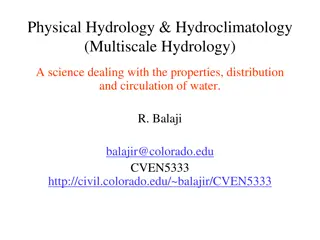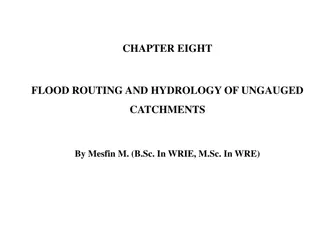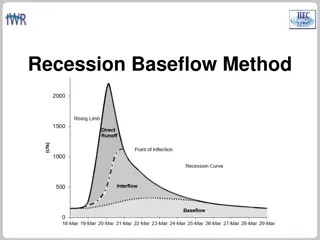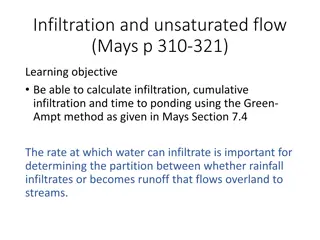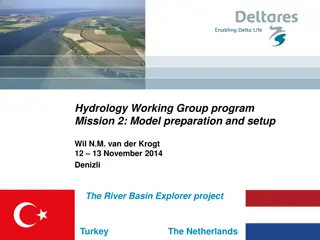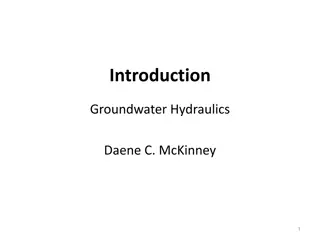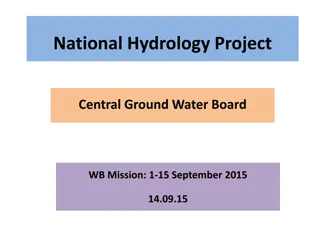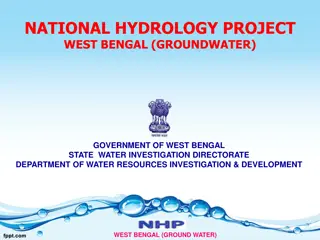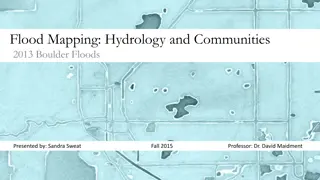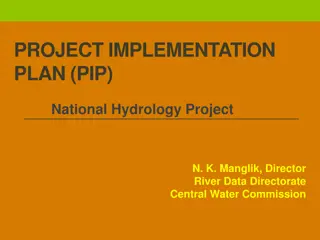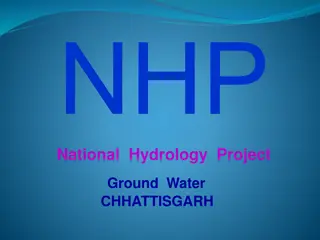
Understanding Hydrology and Its Applications
Explore the world of hydrology, including its significance in civil engineering projects, the hydrologic cycle, and key components such as precipitation, evaporation, and infiltration. Learn about the sources of water, the scope of hydrology, and its application in various projects.
Download Presentation

Please find below an Image/Link to download the presentation.
The content on the website is provided AS IS for your information and personal use only. It may not be sold, licensed, or shared on other websites without obtaining consent from the author. If you encounter any issues during the download, it is possible that the publisher has removed the file from their server.
You are allowed to download the files provided on this website for personal or commercial use, subject to the condition that they are used lawfully. All files are the property of their respective owners.
The content on the website is provided AS IS for your information and personal use only. It may not be sold, licensed, or shared on other websites without obtaining consent from the author.
E N D
Presentation Transcript
ESHAN COLLEGE OF ENGG FARAH MATHURA FARAH MATHURA NAME-DEEPAK KUMAR BRANCH-CIVIL ENGG SUB-ENGINEERING HYDROLOGY
Learning Objectives 1. Hydrology & Hydrology Cycle 2. Rainfall Measurement 3. Analysis of Rainfall Records 4. Runoff Calculations 5. Abstraction from rainfall a) Evaporation b) Evapotranspiration c) Infiltration
1. Hydrology & Hydrology Cycle Sources of Water: Oceans Ice Caps and Glaciers Groundwater Lakes Soil Moisture Atmosphere Streams and Rivers 97.25% 2.05% 0.68% 0.01% 0.005% 0.001% 0.0001% Definition of Hydrology: Hydrology is a multidisciplinary subject that deals with the occurrence, circulation and distribution of the waters of the Earth.
1. Hydrology & Hydrology Cycle Application of Hydrology: Hydrology is applied to major civil engineering projects suchas Irrigation schemes, Dams and Hydroelectric Power Projects, and WaterSupply Projects. Scope of Hydrology: The study of hydrology helps us toknow 1.the maximum probable flood that may occur at a given site and its frequency; this is requiredfor the safe design of drains and culverts, dams and reservoirs, channels and other flood control structures. 2. the water yield from a basin its occurrence, quantity and frequency, etc; this is necessaryfor the design of dams, municipal water supply, water power, river navigation,etc. 3.the ground water development for which a knowledge of the hydrogeology of the area, i.e., of the formation soil, recharge facilities like streams and reservoirs, rainfall pattern, climate, cropping pattern, etc. arerequired. 4. the maximum intensity of storm and its frequency for the design of a drainage project in the
1. Hydrology & Hydrology Cycle Hydrologic Cycle: Journey of water from the ocean to atmosphere and back to the earth and ultimately to the ocean through the processes of evaporation, precipitation,percolation, runoff and return to the ocean is called hydrologic cycle.
1. Hydrology & Hydrology Cycle Components of the Hydrologic Cycle : Precipitation: Includes rain, snow and other forms of water falling from the atmosphere into the land & oceans. Evaporation Physical process by which water is vaporized into the atmosphere from free water surface and land areas. Transpiration: Water from the soil is absorbed by plant roots and eventually discharged into the atmosphere through little pores in the leaves calledstomata. Evapotranspiration: Combined processes by which water is transferred to the atmosphere from open water surfaces and vegetation. Infiltration: Movement of water from the land surface to the upper layers of the soil. Percolation: Movement of water through the subsurface down to the water table. Overland flow: Portion of runoff that travels over the surface of the ground to reach a stream channel Surface runoff: Includes all overland flow as well as precipitation falling directly onto stream channels.
1. Hydrology & Hydrology Cycle Forms of Precipitation: Drizzle: a light steady rain in fine drops (0.5 mm) and intensity <1 mm/hr Rain: the condensedwater vapour of the atmosphere falling in drops (>0.5 mm, maximum size 6 mm) from the clouds. Glaze: freezing of drizzle or rain when they come in contact with cold objects. Sleet: frozen rain drops while falling through air at subfreezing temperature. Snow: ice crystals resulting from sublimation (i.e., water vapour condenses to ice) Hail: small lumps of ice (>5 mm in diameter) formed by alternate freezing and melting, when they are carried up and down in highly turbulent air currents. Dew: moisture condensed from the atmosphere in small drops upon cool surfaces. Frost: a feathery deposit of ice formed on the ground or on the surface of exposed objects by dew Fog: a thin cloud of varying size formed at the surface of the earth by condensation of atmospheric vapour Mist: a very thin fog
1. Hydrology & Hydrology Cycle Types of Precipitation 1. Convectional Precipitation It results from the heating of the earth's surface. Due to this, the warm air rises rapidly into the atmosphere. As the air rises, it cools. Water vapour in the air condenses into clouds and precipitation. 2. Orographic Precipitation: It results when warm moist air moving across the ocean is forced to rise by large mountains.As the air rises, it cools. As air cools, the water vapour in the air condenses and water droplets form. Precipitation occurs on the windward side of the mountain. The air is now dry and rises over top the mountain. As the air moves back down the mountain, it collects moisture from the ground via evaporation. 3. Cyclonic Cyclonic or Frontal precipitation results when the leading edge of a warm, moist air mass
ConvectionalPrecipitation Orographic Precipitation Frontal Precipitation
2. Rainfall Measurement Storm (Heavy Rain) Characteristics: The characteristics of a storm, namely depth, duration, intensity and distribution, affect the watershed response to the rainfall event. Depth Amount of precipitation that falls (usually in or cm). Duration Length of a storm (usually min, hr or day) Intensity Depth of rainfall per unit time (usually in/hr or cm/hr). Rainfall intensity Changes continuously throughout a storm, but it may be averaged over short time intervals or over the entire storm duration. Distribution Describes how rainfall depth or intensity varies in space over an area or watershed
2. Rainfall Measurement Measurement of rainfall and optimum number of rain gauges: The basic instrument for rainfall measurement is rain gauge, which samples the incidence of rainfall at a specific point, through an orifice of known area. Types of Rain Gauges: 1. Non-Recording Rain Gauge The non-recording rain gauge used in India is the Symon s rain gauge. The rainfall is measured every day at 08.30 hours IST. During heavy rains, it must be measured three or four times in the day, lest the receiver fill and overflow, but the last measurement should be at 08.30 hours IST. 2. Recording Rain Gauge a) Tipping Bucket Rain Gauge b) WeighingType Rain Gauge c) FloatingType Rain Gauge This type of gauge is used by Indian Meteorological Department (IMD).
2. Rainfall Measurement Optimum number of rain gauges: Statistics has been used in determining the optimum number of rain gauges required to be installed in a given catchment. The basis behind such statistical calculations is that a certain number of rain gauge stations are necessary to give average rainfall with a certain percentage of error. If the allowable error is more, lesser number of gauges would be required. The optimum number of rain gauges (N) can be obtained using: Where, Cv = Coefficient of variation of rainfall based on the existing rain gauge stations; = Mean / Standard Deviation of rainfall E =Allowable percentage error in the estimate of basic mean rainfall
3. Analysis of Rainfall Records Estimating missing rainfall data: Due to the absence of observer or instrumental failure rainfall data record occasionally are incomplete. In such a case one can estimate the missing data by using the nearest station rainfall data. If for example rainfall data at day 1 is missed from station X having mean annual rainfall of Nx and there are three surrounding stations with mean annual rainfall of N1, N2, and N3 then the missing data Px can beestimated. 1. Arithmetic Mean Method: If N1, N2, and N3 differ within 10% of Nx, Px = (P1 +P2+P3)/3 2. Normal Ratio Method: If N1, N2, or N3 differ by more than 10% ofN x 3. Reciprocal Inverse WeighingFactor Where Xn = Distance between the missing data gauge and the other gauges surrounding the missed gauge.
3. Analysis of Rainfall Records Estimation of average depth of rainfall over a catchment: 1. Arithmetic Mean Method The central assumption in the arithmetic mean method is that each rain gauge has equal weightage and thus the mean depth over a watershed is estimated by: It is a simple method, and well applicable if the gages are uniformly distributed over the watershed and individual gage measurements do not vary greatly about their mean.
3. Analysis of Rainfall Records 2. Thiessen Polygon Method Disadvantage: The disadvantages of the Thiessen method are its inflexibility that is addition of new station implies construction of new polygon, and it does not directly account for orographic influencesof rainfall.

